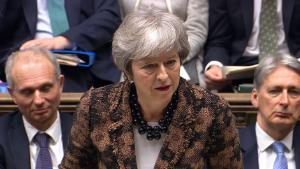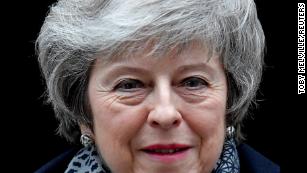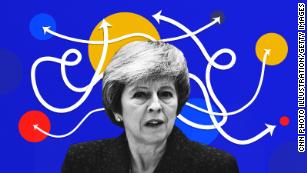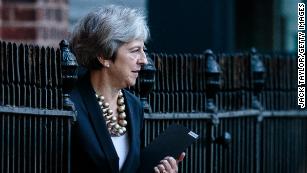Time is running out and Theresa May's Plan B for Brexit is Plan A all over again
Less than a week after her Brexit plan was defeated in the House of Commons by a record number of votes, Theresa May needed to have something substantial to tell lawmakers when she returned to Parliament on Monday.
The UK Prime Minister has spent the last few days in talks with lawmakers from all parties to try to break the stalemate on Britain's withdrawal from the European Union -- with the notable exception of the leader of the opposition, Jeremy Corbyn.
The 'zombified' state of British politics, explained
So far, those talks have resulted in little change to her Brexit plan. But, having promised to unveil a Plan B, the PM insisted some progress had been made.
In the most headline-grabbing of announcements, May announced that the controversial registration fee for EU citizens living in the UK and wanting to remain after Brexit would be waived.
The PM said she would return to Brussels to try to renegotiate the contentious Northern Ireland backstop, which Brexiteers want to be stripped out of the withdrawal agreement. But on the two big demands of lawmakers most critical of Brexit -- ruling out a no deal Brexit, which many fear would damage the UK economy, and allowing a second referendum -- May said her government would not allow either move.
Lawmakers who support these demands will now do everything they can to try to get a Commons vote on these proposals.
The Prime Minister insisted she believed "we can make progress on the substance of the deal."
A restatement of Plan A, with some assurances
Yet, with 67 days to go until Britain is due to leave the EU, time is rapidly running out.
Crucially, what May told MPs in her statement hardly amounts to a Plan B, a reshaped Brexit plan that can go back to Brussels for renegotiation. They are, effectively, a restatement of her Plan A with some reassurance that the Northern Ireland issue will, at some point, be resolved.
One graphic that almost explains Theresa May's Brexit options
For everyone watching the ticking clock in Westminster, May's statement was an extraordinary exercise in refusing to change course.
Amidst all of this, the procedures of Parliament and the EU mean the clock is running down faster than ever.
There are still more in-depth talks to be had between the PM, her ministers and lawmakers in the coming days.
Next Tuesday, January 29, lawmakers will vote on a series of amendments to indicate what kind of Brexit they want to see. But it will not be "meaningful" on the scale of the vote last week -- that is unlikely until February -- but an opportunity for alternative plans to be voted on by lawmakers.
No deal the 'most likely outcome'
Given that anything changed or agreed by the UK parliament will need to go back to Brussels for approval, there is unlikely to be meaningful progress on Brexit until mid-February at the earliest. At that point, it will be just over a month to go until the Brexit deadline of March 29.
If a deal has not been agreed by both Brussels and UK parliament by then, the country crashes out of the EU without a deal.
This no deal scenario is, according to leading Brexiteer and Conservative lawmaker Jacob Rees-Mogg on Monday, now the most likely outcome of the Brexit process.
Brexit 'plot' by lawmakers 'extremely concerning,' Downing Street says
The government and UK businesses are spending a vast amount of money and effort preparing for a no deal. Yet in her statement May claimed that explicitly ruling out a no deal would mean revoking Article 50, the measure that set the timetable for Brexit, and in turn this would mean the UK staying in the EU forever -- a claim that will be greeted with skepticism by constitutional experts. She also warned that allowing a second referendum would risk damaging "social cohesion" in the country.
Less than two days after a car bomb planted by a dissident republican group exploded in Londonderry, also known as Derry, Northern Ireland, the Prime Minister insisted that, despite reports, she would not reopen the Good Friday Agreement that secured a fragile peace in the province. Instead, efforts would be stepped up to change the terms of the Irish backstop, the measure in the Brexit withdrawal agreement that prevents a hard border.
Yet besides the waiving of the fee for EU citizens, very little has changed in May's Brexit strategy. It is as if she narrowly lost last week's vote, rather than the reality -- that lawmakers defeated her plan by 230 votes.
With time running out, May's Brexit plan is back to square one.
News Courtesy: www.cnn.com














